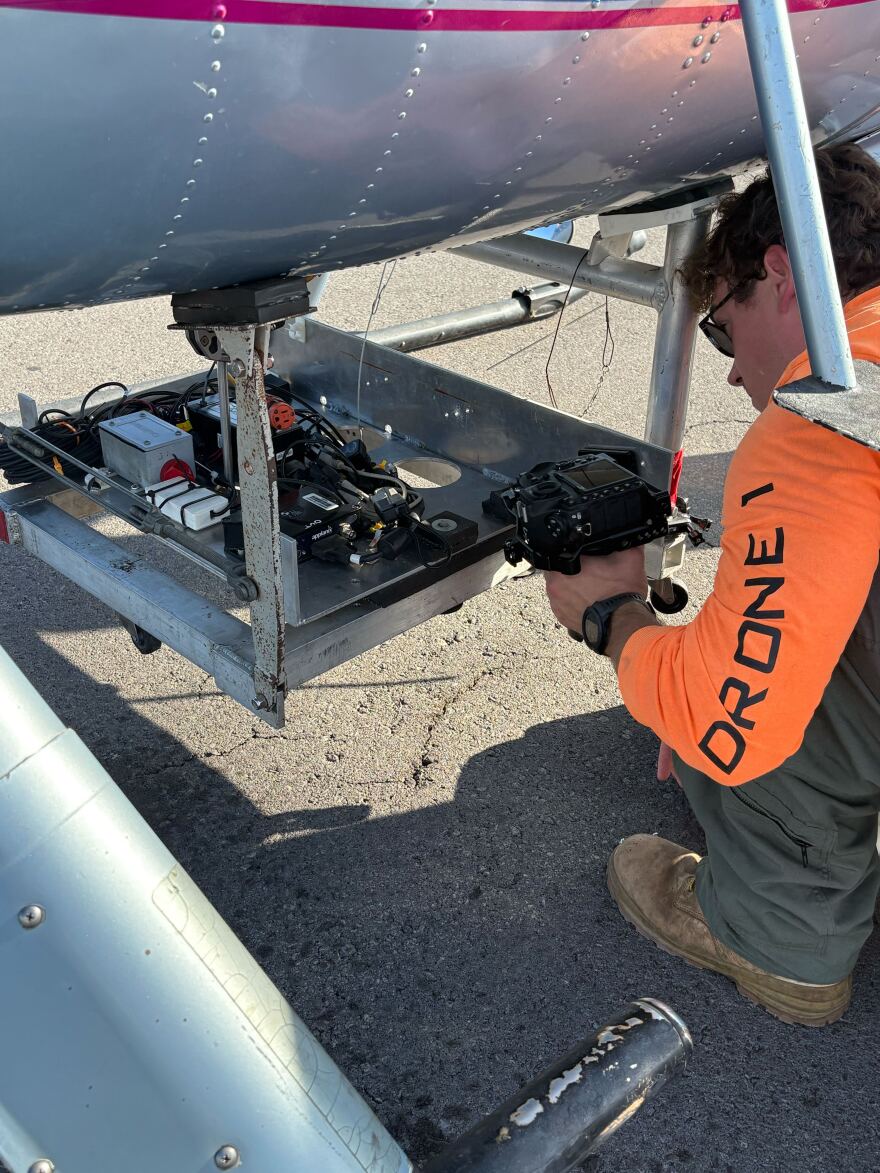Amid Kona's black lava fields, Keāhole Agricultural Park appears like a lush oasis. Mangoes, plumerias, and palm trees grow tall and green, standing in stark contrast to the brown fountain grass that surrounds the park on all sides.
"Unfortunately, this is the perfect environment for coconut rhinoceros beetle to start to breed and build its population," said Franny Brewer, the program manager for Big Island Invasive Species Committee.

Located about a mile from the Kona International Airport, the state-run ag park is home to more than two dozen local landscaping businesses and plant nurseries.
Brewer said the ag park is likely "ground zero" for a serious infestation of CRB that has been plaguing Hawaiʻi Island's west side since March and threatens to fundamentally change the Kona coast.
CRB bore into the tops of coconut trees and other palms in order to feed on sap. Repeated damage from the beetles can kill an otherwise healthy tree.
"What we would stand to lose here is that iconic landscape of Kona, which is that background of palm trees," Brewer said.
Over the last six months, there have been multiple detections of adult beetles within the park. In August, state and county officials stepped in to fumigate green waste piles that were found to contain 110 late-stage CRB larvae.
And the beetle's radius is getting bigger. It has now been detected at several locations along a 20-mile stretch of the Kona coast, including as far north as Kīholo State Park Reserve.
Brewer said that the Big Island Invasive Species Committee has redirected nearly all its resources towards ensuring that CRB doesn't gain a permanent foothold on Hawaiʻi Island.
"With any invasive species, you have a window of time in which it might be possible to eradicate it, and this one, we're still in that window,” she said.
Tracking CRB from new heights
Brewer met with colleagues from the University of Hawaiʻi at Hilo’s Spatial Data Analysis and Visualization Lab in Kona on Tuesday to conduct an aerial survey of the Kēahole Ag Park and residential area above it, Kona Palisades.
Just before 9 a.m., a helicopter rigged with a camera lifted off from Kona Airport. It flew low over the ag park before zig-zagging its way up the slope of Hūalalai towards Palisades.

Over the course of the morning, the helicopter surveyed roughly 4,500 acres. The imagery it captured will help identify signs of beetle damage in palms or piles of green waste that may harbor larvae.
Brewer watched the helicopter's progress from the ag park. It was a clear day, and she could see straight up to the summit of Hūalalai.
"We're looking at thousands of homes, right? Going door to door and knocking on everybody's door and saying, 'Hey, do you have a palm tree? Do you have a pile of mulch in your backyard?' That's a lot of work," she said. “This will really help us target our resources."
Caz DiMarco could hear the helicopter buzzing above him as he started his workday. He runs ʻIli Kūpono Gardens Nursery & Farm with his family on a parcel at the northeast corner of the ag park.
CRB poses a big threat to DiMarco's business. At his nursery, he cultivates about 50 varieties of palm. He said selling those trees generates about half of his company’s total income.
"We are a little bit in jeopardy, to be honest," he said. "If these things take over and start just killing things faster than we can grow them, then…we're going to lose these species of palms."
Conservation efforts up and down the west side
Up the coast at Kīholo State Park Reserve, resource managers are contending with their own challenges.
The nonprofit Hui Aloha Kīholo works with state officials and the Nature Conservancy to steward the reserve, which features a 2-mile stretch of black sand beach dotted with anchialine pools and Native Hawaiian fishponds.

Hui Aloha Kīholo Executive Director Chad Wiggins said two adult beetles have been found at Kīholo. His group is working to monitor CRB traps and manage waste piles. But he said much of the reserve's roughly 4,280 acres is inaccessible due to dense kiawe and hau forests.
"Even if we could get to them, it wouldn't be viable for us to pull everything out of there," he said.
The group is also limited in how it can use insecticides to deter CRB.
Kīholo Bay is lined with coconut palms, some of which are more than 150 years old. It also has ancient groves of loulu, or endemic fan palms.
Loulu are of particular concern when it comes to CRB, because they are far more likely to succumb to beetle damage than heartier coconut trees.
Some places, like the Amy Greenwell Ethnobotanical Garden in South Kona, have taken the step of injecting insecticides into loulu in an effort to preserve delicate species.
"We decided for our wild collected specimens of loulu palms, which are critically endangered, that it was in the best interest of conserving those species," said Greenwell garden manager Joe Pryzdia.
But Wiggins said insecticides could negatively impact Kīholo's aquatic habitats.
"The groundwater lens under Kīholo is very close to the surface at the shoreline, and there are a lot of sensitive native ecosystems, including anchialine pools and fishponds, that would be directly affected by any kind of a toxin that enters that groundwater system," he said.
Wiggins said he's hoping for the development of an effective, nontoxic treatment for CRB, as well as more investment in the fight against the beetle on Hawaiʻi Island's west side.
"It's possible that we could prevent this beetle from becoming established on our island, and Kīholo is one of the places where that investment would need to be carried out on the ground," he said.

Hawaiʻi Public Radio exists to serve all of Hawai’i, and it’s the people of Hawai’i who keep us independent and strong. Help keep us strong to serve you in the future. Donate today.





